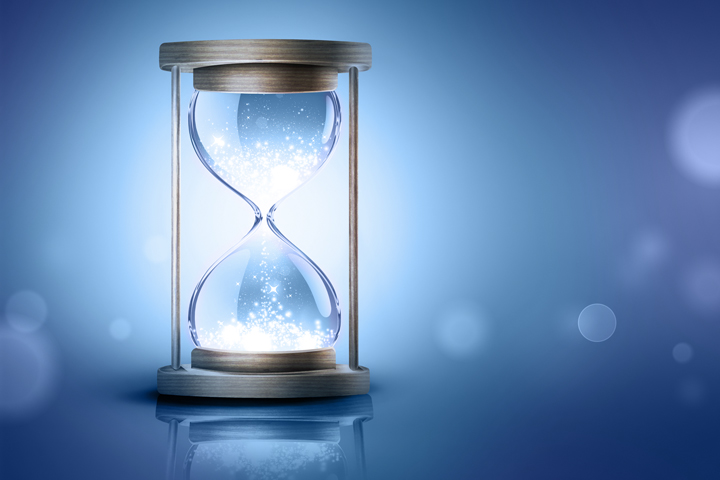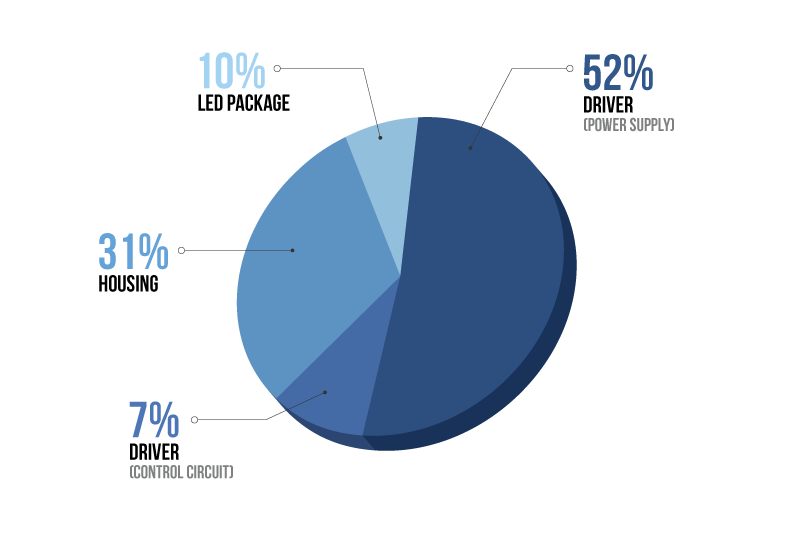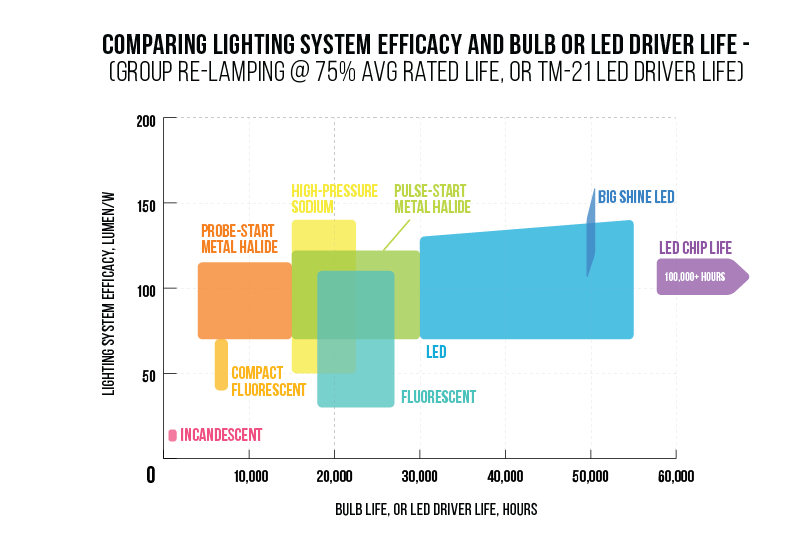
Written by August Kruesi
Chief Technology Officer, Big Shine LED
Lumen Depreciation
One of the outstanding features of today’s LED lighting systems is the potential for remarkably long life, far beyond that of traditional lighting. LED lighting is a new technology, and LED terminology, testing, and life prediction can be confusing. LED light will very slowly depreciate (decrease) over time. Lumen depreciation accelerates under adverse conditions, such as high temperature. At some point, the reduction in light output becomes objectionable. A gradual color shift can also occur. The accepted method to predict the life of an LED light is to operate a sample of the LED packaged chips for 6,000 to 8,000 hours at three different temperatures. Based on these results, a mathematical calculation is used to estimate the operating hours for the light (lumen output) to depreciate to 70% of its original value. This is known as the L70 life estimate.
Lifespan Testing Standards
LM-79
Several new standards have been developed in response to the need to define test methods and life estimation for LED lighting. The most important standard for architects, engineers, lighting designers, and business managers planning a lighting upgrade is LM-79. LM-79 is short for the IES LM-79-08 Approved Method: Electrical and Photometric Measurements of Solid-State Lighting Products. The U.S. Department of Energy describes the LM-79 method as being “applicable to integrated LED products, such as luminaires and replacement lamps. It is not applicable to LED packages, modules, or arrays (herein collectively referred to as LED light sources).”1 LM-79 test reports provide data about the initial lumen output and distribution, and may also include changes over a period of 6,000 hours or more.
LM-80
The IESNA (Illuminating Engineering Society of North America) also developed LM-80-08 Approved Method: Measuring Lumen Maintenance of LED Light Sources (LM-80). LM-80 data determines changes in LED chip light output and color shift when operated at three different temperatures, with a 6,000-hour minimum at each temperature. Manufacturers of LED lighting fixtures primarily use LM-80. It does not represent the in situ performance of an installed LED lighting fixture and electronic driver as a Solid-State Lighting System (SSL).
TM-21
Both the LM-79 and LM-80 standards are important. In addition, a companion is the IESNA TM-21-11 Projecting Long Term Lumen Maintenance of LED Light Sources (TM-21).2 The term “lumen maintenance” means the ability of the light to maintain its original output and properties over time. It is impractical to test LED light components and systems for their full L70 life because this might require continuous testing for 5, 10, 20 years or more. As a result, the TM-21 method was developed. TM-21 uses a mathematical model to project, or estimate, what the L70 life of an LED light will be using the LM-80 photometric data.
Comparison
If the L70 life is calculated to be greater than 6 times (6x) the actual test duration, it is recommended to state the L70 life as “> the 6x hours.” For example, if the LM-80 test duration was 8,000 hours, the L70 estimate should be stated as “> 48,000 hrs” even if the mathematical calculation indicates the L70 life will be 120,000 hrs. Energy Star testing for LED lighting provides a benchmark. However, the life of the LED driver or fixture in your building may differ depending on actual temperature and conditions.
LED Lighting System Life
As the user, you want to know how long the LED lighting will last before you have to think about component or light fixture replacement. Depending on the type of lighting system installed, a replacement may become necessary due to the reduction in light output, color shift, or it may be due to a failure of the dimming function or of the light itself. The correct way to look at a fixture’s expected lifespan is to evaluate LED lighting as a system. Whatever component of the system has the shortest life will determine the lifespan that is usable and economical for you.
However, some lighting manufacturers and distributors are advertising phenomenal life. For example, one brochure that I came across stated, “Fixture life is up to 361,000 hours.” This is over 41 years of continuous operation! What they fail to explain is that their prediction is based only on the LED chip itself. It does not include the electronic driver or any other component. The driver is the heart of the LED light. Driver life can range from 10,000 to over 50,000 hours, depending on the design features, heat sink efficiency, capacitor construction, and overall quality. While advertising 360,000+ hours may be attractive to customers now, down the road, they will suffer a loss. The actual warranty won’t match such a wild claim.
Important Diagrams
The below diagram shows the components of an LED lighting system. The life of any of these components affects the umen output, consistency, distribution, and color. In other words, the fixture lifespan should not be rated on the basis of the LED chip alone.
FIGURE 1 – SSL Reliability Management Diagram

The pie chart in Figure 2 represents the distribution of failures in 34M operating hours for a family of outdoor luminaires. Total number of failures was 29, or 0.56% of installed base of approximately 5,400 fixtures. (Source: Appalachian Lighting Systems, Inc.3)
FIGURE 2 – Distribution of Failures in Outdoor Luminaires

To put all this in perspective, the graph in Figure 3 compares the ranges of estimated life for traditional and LED lighting using the shortest life component of the lighting system, or the L70 life, whichever comes first. Big Shine Energy will be glad to further explain the practical estimates of life and what you can expect.
FIGURE 3 – Estimated Lifespan for LED

Conclusion
At Big Shine LED, we view the lighting system as a full-service program, including giving you honest estimates of life. We provide guidance regarding factors that can lead to premature dimming or failure. In order to do this, we property match the lighting system to the operating environment. We consider both the driver and the light fixture. In particular, excess heat above the rated limit will rapidly degrade the life of LED lighting, as will dust (which can cover and block heat dissipation fins), moisture (if not properly IP-rated), and power quality, including low voltage fluctuations and harmonic distortion.
Our goal Is to provide you with the best lighting installation to meet your needs. We want to give you honest expectations on your LED lighting system life. We will calculate the realistic payback for you and back up our installation with the best service. Contact us if you have any questions.
References
- U.S. Department of Energy. (2012, March). Understanding LM-79 Reports. Solid-State Lighting Technology Fact Sheets. Retrieved from https://www.energy.gov.
- Tuttle, R., Haraguchi, K., Hodapp, M., Jiao, J., Miller, C., Ohno, Y. et al. (2011, May). TM-21 Update: Method for Projecting Lumen Maintenance of LEDs. Retrieved from https://www.cormusa.org.
- LED LUMINAIRE LIFETIME: Recommendations for Testing and Reporting, Solid-State Lighting Product Quality Initiative, Second Edition January 2011; Next Generation Lighting Industry Alliance with the U.S. Department of Energy.
- Lifetime and Reliability; U.S. Department of Energy Solid-State Lighting Technology Fact Sheet; PNNL-SA-97534, August 2013.
- Jiao, Jianzhong PhD; “IES TM-26 prescribes LED failure rate projection”, LEDs Magazine, April 1, 2016.
About the Author: August Kruesi, Big Shine LED Chief Technology Officer
August Kruesi‘s career spans 40 years in renewable energy, aerospace, medical devices, and advanced composites. Mr. Kruesi holds U.S. and international patents. He earned a B.S. in Mechanical Engineering, M.S. in Integrative Health Science and Black Belt Certification in Design for Six Sigma (DFSS). He is Instructor Emeritus for his class, Research Methods in Integrative Medicine. Lighting is not new to Kruesi, great-grandson of John Kruesi—a Swiss-born scientist and Thomas Edison’s “right-hand man,” who worked on all of Edison’s most important developments, including the electric light bulb.







